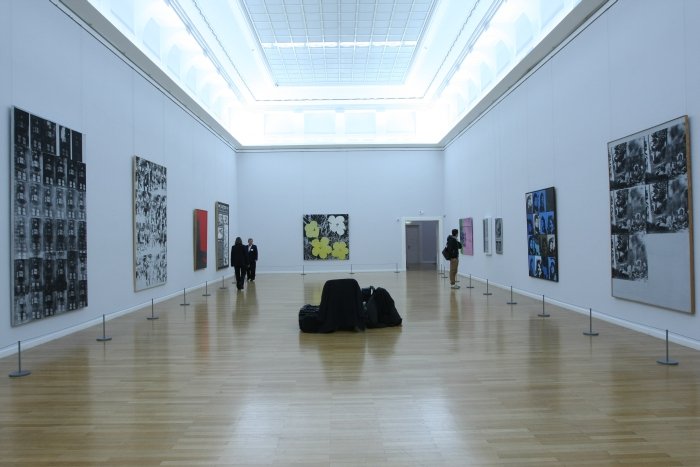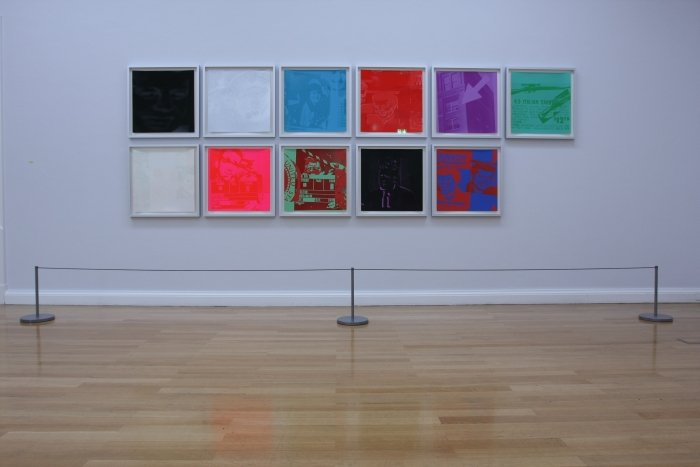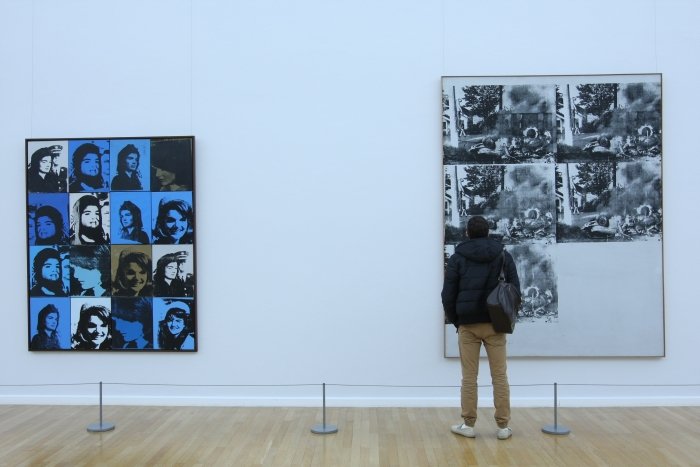Much as Andy Warhol predicated we'd all be famous for 15 minutes, he also understood we'd all be dead forever.
And that he dealt with the inevitably of death in all its poetic, brutal and unjust facets in works of art every bit as lively, critical and complex as those he created to deal with the vagaries of celebrity, trash culture and consumerism can currently be experienced in the exhibition "Andy Warhol – Death and Disaster" at the Kunstsammlungen Chemnitz.

Much like displaying a Konstantin Grcic exhibition was one of Mateo Kries and Marc Zehntner's first aims on taking control of the Vitra Design Museum, so to was Andy Warhol an early wish of Ingrid Mössinger upon taking up the position of Director General at the Kunstsammlungen Chemnitz. Her wish began to become reality when in context of the museum's 2012 Picasso exhibition she was introduced to the art dealer, collector and gallerist Heiner Bastian. A friend of Warhol since the early 1970s Heiner Bastian has published numerous texts on Warhol and was responsible for the Neue Nationalgalerie Berlin's 2002 Andy Warhol retrospective, an exhibition which was subsequently shown in the Tate London and Museum of Contemporary Art, Los Angeles. Through conversations between Bastian and Mössinger the idea slowly developed of presenting Warhol's so-called "Death and Disaster" series in Chemnitz. You'll forgive us if we refrain from making our customary disparaging remarks about Chemnitz. Yes, we've experienced unhealthy, unnecessary, volumes of death, near death, disaster and raw brutality in Chemnitz, but no, the reasons therefore don't provide the social and cultural context that make the presentation of the Warhol works in the Kunstsammlungen appear so natural. So obvious. As if they belonged in Chemnitz.
According to Heiner Bastian Andy Warhol's artistic focus on the more morbid and unsavoury aspects of life began in the summer of 1962 as he was developing his screen printing techniques. Marilyn Monroe committed suicide, 129 people died when Air France flight 007 crashed on take off, and Warhol realised that all his work was, in one form or another, associated with death and so he decided to use it to give the victims, the dead, a face, a story, a relevance. A persona if you will.
Thus one has the curious situation that just as Warhol was perfecting his technique for removing the artist from art, he was beginning with the creation of arguably his most personal and personalised works.

Presenting some 61 objects created between 1962 and the mid 1980s, Andy Warhol – Death and Disaster at the Kunstsammlungen Chemnitz includes works such as Skull, Flowers, Suicide, Sixteen Jackies or Electric Chair, a work which is perhaps most impressively presented as a family of 10 prints in various tones. A presentation which also highlights that although 61 "objects" are on display, there are only 12 themes/images; repeated in various materials, colours, formats and contexts. But with Warhol that's OK, the industrialisation, repetition and mass reproduction of art being amongst his main themes.
The repetition also helps make the images seem less threatening despite the appalling, brutal nature of many of the works, and thus helps create a more accessible exhibition than would/could/might otherwise be the case. Through the variation one has the distance to concentrate on the message rather than the image. That may not give the subjects the persona Warhol strove for, but does focus on their fate.
Slightly disappointing is what is not on show, most notably "129 Die in Jet" and "Marilyn Diptych", the works which arguably began the series. Disappointing as that is, the selection of works which Heiner Bastian and the Kunstsammlungen Chemnitz are presenting is more than adequate to allow the visitor to understand not only one of Warhol's most interesting and challenging artistic explorations but also the man behind the bright, vivacious screen prints, graphics and Coca-Cola bottles.

In conversation Heiner Bastian impresses that the works in the death and disaster series aren't pop art; having nothing to do with the disposable nature of everyday culture as represented in pop art. While not wanting to contradict a man like Heiner Bastian, and freely accepting and acknowledging that we are barely qualified to do such even if we wanted to - we'd argue, what is as expendable, as temporary, as transient as life. As Malcolm Middleton so adeptly phrases it "there’s a when not an if inside everybody" Or, and to remain in the Warhol vocabulary, are we all, ultimately, not just tins of soup? We have a use by date, an expiry date. But will we survive that long? Or will disease, crime, misfortune, political unrest or suicidal tendencies condense things?
And just as there is nothing as transient as life, so to is there nothing quite as permanent as death. Andy Warhol understood that. And perhaps that is why he wished everyone 15 minutes of fame.
Before the indignity, and anonymity, of death.
Andy Warhol - Death and Disaster can, and indeed should, be viewed at the Kunstsammlungen Chemnitz, Theaterplatz 1, 09111 Chemnitz until Sunday February 22nd 2015
Full details, including information on the extensive fringe programme can be found, albeit sadly only in German, at www.kunstsammlungen-chemnitz.de